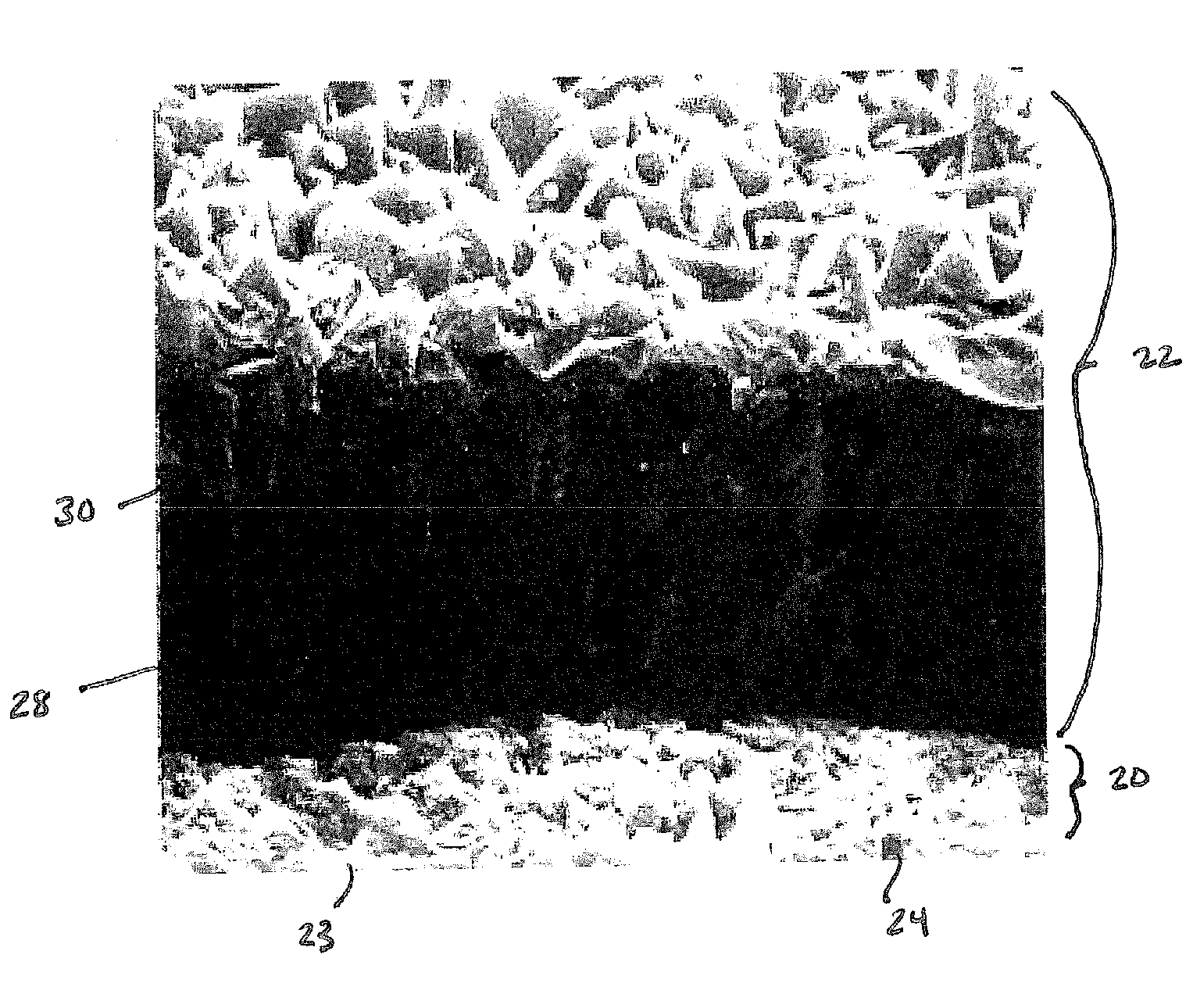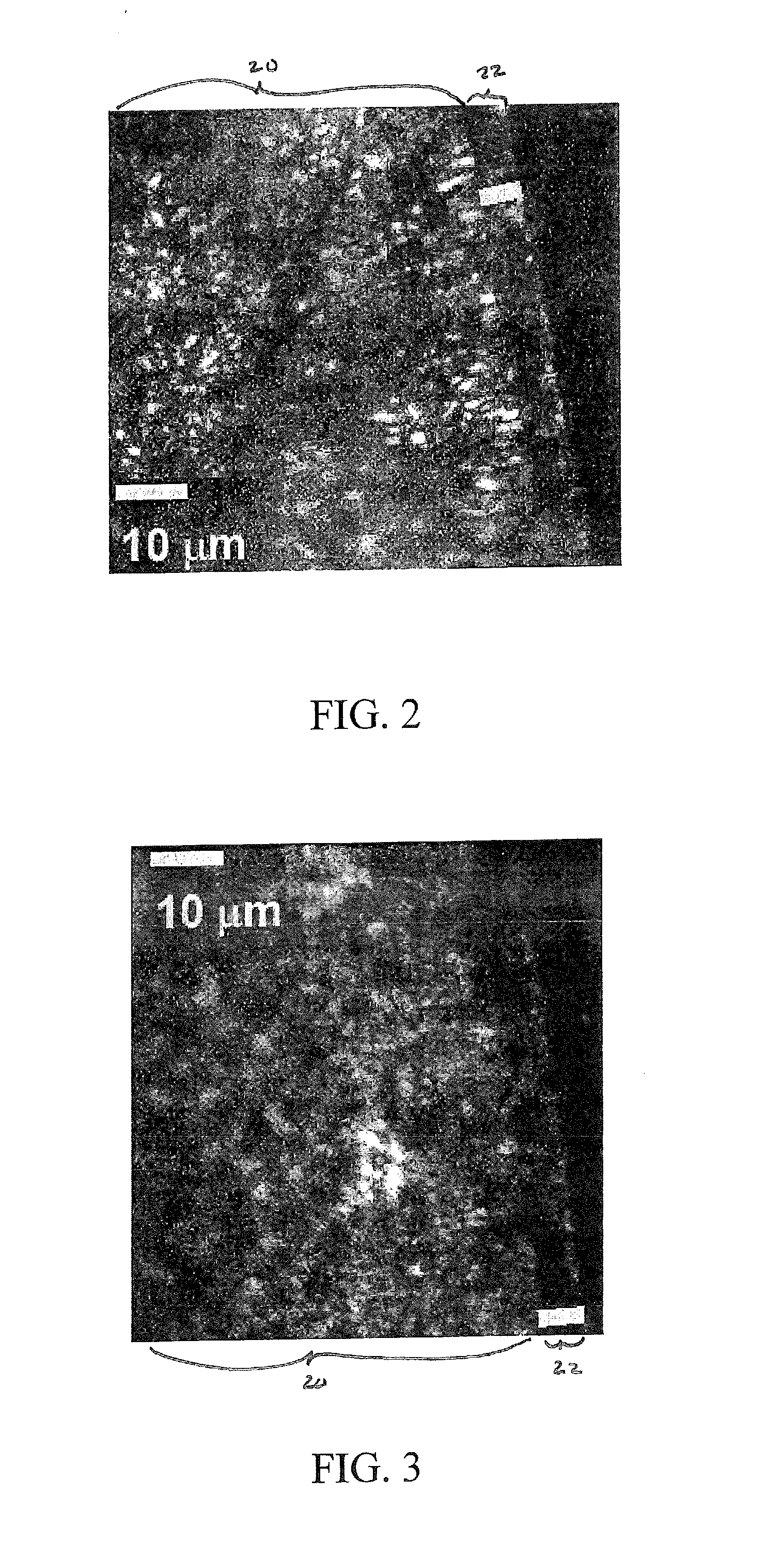Process for diffusing titanium and nitride into a material having a coating thereon and products produced thereby
a technology of nitride and titanium, which is applied in the direction of solid-state diffusion coating, vacuum evaporation coating, transportation and packaging, etc., can solve the problems of nitriding process deficiency, insufficient iron for nitrogen to react with, and only good bond strength of coating, etc., to achieve the effect of improving the properties of titanium
- Summary
- Abstract
- Description
- Claims
- Application Information
AI Technical Summary
Benefits of technology
Problems solved by technology
Method used
Image
Examples
example 1
[0031]FIGS. 1 and 2 illustrate base material 20 containing carbide having a CVD coating 22 thereon. As shown in these figures, the base material 20 includes a generally compact, granular microstructure. Although the granular microstructure contributes to the hardness of the carbide, among the grains 23 are small voids 24 which perpetuate the brittleness of the carbide structure. In order to compensate for this brittleness, a coating may be formed thereon.
[0032]A CVD coating 22 is shown to be applied to the base material 20 using any conventional CVD process. More specifically, the base material may be exposed to one or more volatile precursors, which react and / or decompose on the base material to produce the desired coating 22. For example, titanium carbo-nitride+alumina may be used (TICN+Al2O3). Alternatively, titanium nitride+alumina+titanium carbo-nitride (TiN+Al2O3+TiN) may be used. Structurally, the coating 22 is shown to have a crystalline microstructure, wherein among the cry...
example 2
[0037]A metal alloy comprising carbide was used as a base material for a turning insert. The base material additionally included vanadium. The turning insert was further treated with a CVD process. This turning insert was treated by soaking in a heated salt bath (NaCNO and about 10 w / w % of NaCO2), for 2 hours at 545° C. in which 2-20 micrograms of electrolyzed metallic titanium was added. The turning insert was then cooled and dried. The insert was then washed to remove an oxidation layer formed as a result of heat being applied thereto during and after the diffusion process.
[0038]The aforementioned turning insert treated with the present invention process was tested and compared to a turning insert treated only with a CVD process under the same operating parameters:
Material MachinedCarbon SteelWork Diameter 19″Spindle Speed (SFPM)330Feed Rate IPR 0.04Depth of Cut0.25″ per sideLength of Cut4′9″No. of Passes 8
[0039]After testing, the turning insert treated with the present inventi...
example 3
[0040]A metal alloy comprising carbide was used as a base material for a turning insert. The base material additionally included vanadium. The turning insert was further treated with a CVD process. This turning insert was treated by soaking in a heated salt bath (NaCNO and about 10 w / w % of NaCO2), for 2 hours at 545° C. in which 2-20 micrograms of electrolyzed metallic titanium was added. The turning insert was then cooled and dried. The insert was then washed to remove an oxidation layer formed as a result of heat being applied thereto during and after the diffusion process.
[0041]The aforementioned turning insert treated with the present invention process was tested and compared to a turning insert treated only with a CVD process under the same operating parameters:
Material MachinedCarbon SteelWork Diameter 17″Spindle Speed (SFPM)330Feed Rate IPR 0.035Depth of Cut0.25″ per sideLength of Cut5′9″No. of Passes 11
[0042]After testing, the turning insert treated with the present inve...
PUM
| Property | Measurement | Unit |
|---|---|---|
| temperature | aaaaa | aaaaa |
| time | aaaaa | aaaaa |
| temperature | aaaaa | aaaaa |
Abstract
Description
Claims
Application Information
 Login to View More
Login to View More - R&D
- Intellectual Property
- Life Sciences
- Materials
- Tech Scout
- Unparalleled Data Quality
- Higher Quality Content
- 60% Fewer Hallucinations
Browse by: Latest US Patents, China's latest patents, Technical Efficacy Thesaurus, Application Domain, Technology Topic, Popular Technical Reports.
© 2025 PatSnap. All rights reserved.Legal|Privacy policy|Modern Slavery Act Transparency Statement|Sitemap|About US| Contact US: help@patsnap.com



